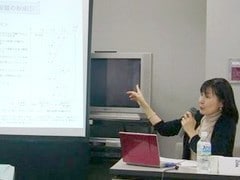BUILDING A MULTIETHNIC SOCIETY & REVITALIZING LOCAL COMMUNITIES
2005–2007
The number of foreign nationals residing in Japan has grown rapidly since 1980, accounting by 2005 for more than 2 million people, or 1.6 percent of the population. As a result, communities around Japan are finding that they need to rethink how they deal with non-native residents. It is important not only to focus on integrating them smoothly into local communities but also to find ways to more effectively utilize their unique potential as resources for communities. With this in mind, JCIE operated a three-year project with community leaders from around the country to examine case studies of areas with active communities foreign-born residents, analyze the roles played by the actors who work as a bridge between foreign and Japanese residents at the community level, and explore ways communities can better support foreign-born residents.
In 2005 and 2006, the research team held a series of meetings with community leaders, activists, and others in six areas with high concentrations of foreign nationals. Each meeting examined the key issues in the locales being studied and the various organizations and mechanisms currently in place to facilitate relationships among community members from different cultural backgrounds. These ranged from rural Yamagata Prefecture, where the many farmers have married Asian brides, to manufacturing areas in Gunma Prefecture and elsewhere where Brazilians and Peruvians of Japanese descent have settled. In many instances, the growth of foreign residents, which aroused concern on the part of local leaders, has helped strengthen local communities by revitalizing local community groups, promoting cultural exchange, and strengthening the economic base.
The project culminated in September 2007 in the publication of a volume in Japanese entitled Tabunka Pawa Shakai (A “Multicultural Power” Society: Going Beyond Coexistence), which relates how foreign residents are helping to revitalize local communities around Japan.
PROJECT ACTIVITIES
February 23–24, 2005 | Research Workshop (Tokyo) |
June 21–22, 2005 | Research Workshop (Tsuruoka, Yamagata Prefecture) |
October 2–3, 2005 | Research Workshop (Oizumi, Gunma Prefecture) |
February 23–24, 2006 | Research Workshop (Kobe) |
March 4, 2007 | Reporting Seminar: “Turning Diversity into Power” (Hamamatsu, Shizuoka Prefecture) |
September 19, 2007 | Final Seminar: “Toward the Realization of ‘Multicultural Power Society’” (Tokyo, Japan) |
September 20, 2007 | Book Launch: “Toward the Realization of ‘Multicultural Power Society’: Going Beyond Coexistence” |
STUDY TEAM
Members
NASUKO YAMAGUCHI, Vice President, Shounai International Exchange Association (Tsuruoka, Yamagata Prefecture)
SHOKO TAKANO, Chief Director, NPO Oizumi Center of International Education and Vocational Training (Oizumi, Gunma Prefecture)
MICHELLE WANG, Representative, Center for Multicultural Information and Assistance—Tokyo 21 (Tokyo)
MASAAKI ISHIHARA, Director, Hamamatsu Foundation for International Communications and Exchanges; Ryoaki Ishizuka, Director, Hamamatsu Foundation for International Communications and Exchanges (Hamamatsu, Shizuoka Prefecture)
JUNKO NAKAGAWA, Director, Nara NPO Plaza (Nara)
SHIZUYO YOSHITOMI, President, Multilanguage Center FACIL (Kobe, Hyogo Prefecture)
Research Director
TOSHIHIRO MENJU, Chief Program Officer, JCIE
Advisor
ERIKO SUZUKI, Gendai Advanced Studies Research Organization




